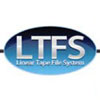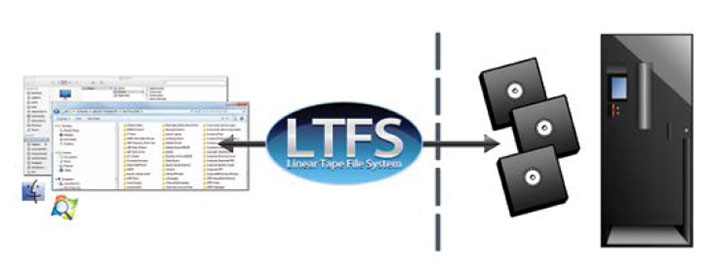
Technology Game-Changer
Linear tape file system revolutionizes video surveillance storage
- By Paul Leury
- May 01, 2013
 According to IBM, 2.5 quintillion new bytes
of information are created each day—that’s
1 with 18 trailing zeros. The explosion of
“Big Data” has touched every industry. Video
surveillance is no exception.
According to IBM, 2.5 quintillion new bytes
of information are created each day—that’s
1 with 18 trailing zeros. The explosion of
“Big Data” has touched every industry. Video
surveillance is no exception.
With regulatory retention demands on the
rise, especially for security data, the dollar-per-gigabyte equation
becomes more important than ever before. New linear tape
file system (LTFS) technology ensures data preservation and enhances
data mobility, offering comprehensive accessibility and
security. There have been advances in tape that help tackle this
cost-capacity challenge and keep all data rapidly accessible, without
devouring a budget.
When a security incident occurs, surveillance footage is often
needed without delay. When data is the cornerstone for resolving
a safety issue, difficulty retrieving critical data could have detrimental
effects. Budget constraints, higher-quality imaging demands,
and state/federal regulatory-compliance standards drive
the need for low-cost digital storage for video surveillance data.
Facing the Challenges
A traditional CCTV–based surveillance system comes with challenges
of low-image quality and limited access. Moving to a
digital IP video surveillance solution brings benefits of scalability,
high-quality imaging, high availability and more centralized
management, but many facilities have been reluctant to change
because of the associated costs of storage and bandwidth constraints.
Due to higher resolutions and better image quality, file
sizes are continuously growing to accommodate more pixels and
image detail.
A good deal of the cost—as much as 50 percent in some cases—
is due to the additional data storage capacity needed to support
the upgraded systems. Additionally, higher-quality imaging
delivered by IP cameras is becoming essential for facilities, such as correctional facilities that are required to meet video-quality
compliance standards. Longer video-retention times come into
play as well, with video evidence becoming increasingly important
in criminal convictions and protection against false insurance
claims.
When considering how to manage surveillance data, a management
software platform is key. Beyond the management, however,
a secure-storage platform should be employed to guarantee
the safety, reliability and accessibility to the data.
While HDD and high-performance SANs are typical for active
data storage, they can become quite expensive and cannot
cost-effectively keep up with the growing storage demands. Surveillance
streams may be coming from hundreds of cameras and
require high-performance applications or media while the data is
streamed from the camera to an encoder or networking switch,
and finally to the centralized control location. In recent years,
this scenario has resulted in a need for an expansive SATA or
SAS disk system.
Re-emergence of Tape
With their scale-out, energy-hungry systems, it’s no wonder that
storage can account for more than 50 percent of today’s surveillance
system costs. But new tape-based technology is quickly
giving security managers hope for more reliable data access and
drastic cost reduction.
Tape has recently re-emerged as a renewed and more powerful
medium for surveillance data. But, tape is slow, unorganized and
difficult to access, one might have heard in the past. While archaic
tape systems certainly came with their fair share of lamentations,
the game-changing LTFS technology has reinvigorated tape as an
easy-to-use, file-based system for high-volume data storage. It’s
turned out to be quite the appealing option for organizations that
depend on large-scale surveillance systems.
Developed by IBM, LTFS refers to the non-proprietary form
and organization of data on LTO (linear tape open) media. LTFS
is a way of organizing data on tape that simplifies rapid file access
while protecting tape from vendor lock-down. In other words, no
specific vendor solution is needed to read data that is stored on
LTFS. The standard empowers tape as a file-based storage medium
without attaching metadata or making modifications to files.
The LTFS software can be downloaded from any major tape
vendor’s Web site and applied to LTO-5 and LTO-6 tape cartridges
and drives. Essentially, LTFS partitions a tape into an index
(partition 0) and a general data area (partition 1). As data is written
to a tape, the index retains enough metadata to know exactly
where on a tape a file resides. The benefit is two-fold: Tape data
can be more efficiently retrieved because an application will not
have to read the entire span of the tape to locate a file, and tape
is now empowered as a file system and can interface with other
file-based applications and software. For the video surveillance
world, this means that once inflexible, offline tape is now a living
part of file-based feeds and surveillance data management.
Tape can now serve as network-attached storage (NAS) because
a tape library can connect and interact with file-based applications.
The tape-as-NAS solution is especially compelling because
it allows a file-system view of tape data from applications
that are familiar to end users. Accessing files from the archive can
be accomplished via simple point and click from the application.
The ease at which this allows users to locate specific surveillance
footage is unmatched.
Vendor Neutral and Cost Effective
LTFS was created to solve the challenge of vendor lock-down on
tape data. Because LTFS is open-standard, it ensures that LTO-
5—and LTO-6, when shipped—can be read by any LTFS-enabled
device, regardless of vendor. LTFS/LTO media can be purchased
from any major tape media vendor and read by another vendor’s
LTFS drive. Thus, data isn’t restricted or in danger of becoming
inaccessible because one vendor’s technology becomes obsolete
or unavailable. By allowing integrators to build surveillance solutions
without worrying if the underlying tape storage layer will
be compatible down the road, a great sense of peace of mind and
assured accessibility is gained.
According to a report authored by The Clipper Group last
year, the operational costs associated with disk-based surveillance
video storage can amount to more than 15 times that of
tape-based storage. Disk requires constant energy for spinning,
cooling and operational tasks. On the other hand, an LTFS tape
library keeps energy needs to a minimum, helping to create a
more sustainable datacenter. Additionally, tape is much more reliable
than disk. LTO boasts a best bit-error rate of 1 x 10e17
(that’s about one bit error every 12 petabytes). Organizations can
buy a 1.5 terabyte LTO-5 cartridge for about $35.
In one study, an analyst found that switching from a SAN disk
solution to an LTFS-based storage system resulted in an 80 percent
reduction in the total cost of ownership for storing data. It’s
noteworthy to add that the study was conducted over a 10-year
period using 1 PB (dual copy) of video data.
Faster Access
As mentioned previously, security data is often needed under
tight time constraints. LTFS makes it simpler and faster to pinpoint
specific files stored on an LTO tape. Because LTFS is a selfdescribing
file system, contents are categorized with the index
stored in the first partition of the media.
Data written on LTFS media can be used for a variety of applications.
Surveillance footage can be shared between different
entities as needed. Tapes from an LTFS library can be exported
and read by any other machine. This allows surveillance professionals
to deliver content as requested or mandated by authorities
or other organizations. It also allows separate groups to more instantly
access and share the video footage, increasing the usefulness
of the surveillance system when needed most.
Data storage is fundamental. Accessibility, performance and
cost-savings are what make one type of storage stand apart from
alternatives. While organizations will certainly continue to employ
disk, SAS or SATA for high-availability surveillance data,
advances in LTFS and LTO tape media are beginning to make
an impact in overall surveillance storage infrastructure designs,
not to mention budgets. LTFS delivers a solution for surveillance
footage that needs to be retained cost-effectively. To cope with
rapidly growing data volumes, the surveillance industry can look
to tape and LTFS as a possible solution for large-volume data
storage and savings.
This article originally appeared in the May 2013 issue of Security Today.